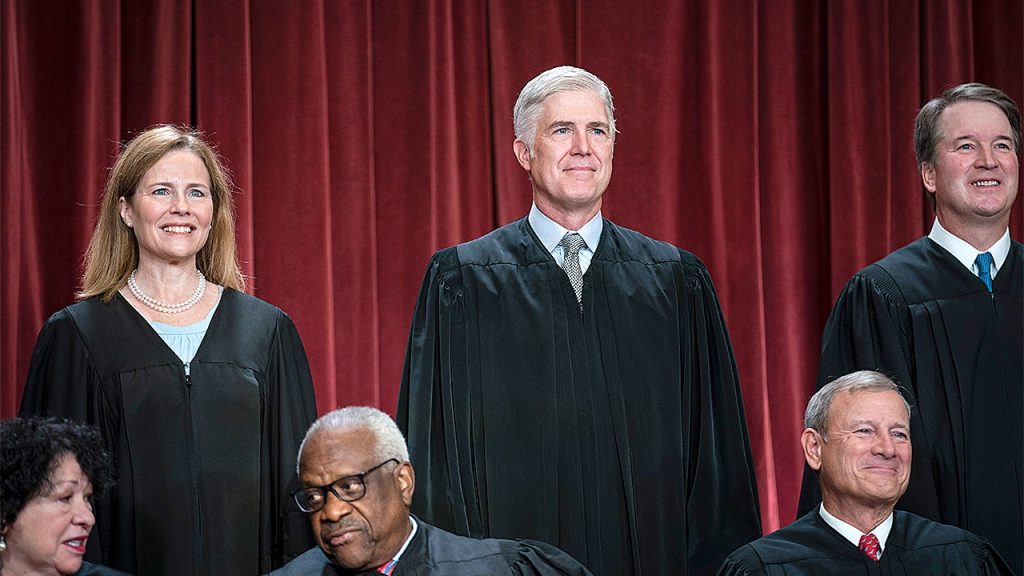Listen to the article
Supreme Court Justices Express Skepticism Over Trump’s Tariff Authority
The Supreme Court heard oral arguments Wednesday in a case that could determine the fate of President Donald Trump’s “Liberation Day” tariffs, with several justices—including Trump appointees—expressing skepticism about the administration’s legal justification for the sweeping import duties.
At issue is Trump’s use of the International Emergency Economic Powers Act (IEEPA) to impose a 10% tariff on most imports after declaring the trade deficit a national emergency. The administration’s interpretation of the law has raised constitutional concerns about separation of powers and presidential authority.
During the two-hour session, justices focused heavily on whether the IEEPA’s language authorizing the president to “regulate importation” during a national emergency extends to imposing tariffs. Justice Amy Coney Barrett, appointed by Trump in 2020, pointedly questioned Solicitor General D. John Sauer on this interpretation.
“Can you point to any other place in the code or any other time in history where that phrase—together with ‘regulate importation’—has been used to confer tariff-imposing authority?” Barrett asked.
Justice Neil Gorsuch, another Trump appointee, raised concerns about the constitutional implications of the administration’s position, asking Sauer about his “theory of the Constitution” and the “major questions doctrine” that limits executive authority on significant economic and political issues without clear congressional authorization.
“What would prohibit Congress from abdicating all responsibility to regulate foreign commerce or declare war to the president?” Gorsuch pressed.
The administration’s position hinges on distinguishing between “regulatory tariffs” and taxes. Sauer repeatedly argued that revenue generation is only “incidental” to the tariffs’ purpose, despite the White House celebrating that Trump’s tariff revenues exceeded $100 billion this year.
Challengers, including businesses and Democratic-led states, contend that when Congress wants to grant presidents tariff authority, it does so explicitly, as with Section 232 (national security measures) and Section 301 (unfair trade retaliation). They argue IEEPA contains no such explicit language, having historically been used for embargoes, asset freezes, and licensing requirements—not broad-based tariffs.
The Court’s more liberal justices appeared aligned with the challengers’ position. Following the 2024 Loper Bright v. Raimondo decision, which eliminated judicial deference to federal agency interpretations of ambiguous laws, courts now require clearer statutory language for major economic actions like Trump’s tariffs.
Legal experts observing the arguments suggested the administration faces an uphill battle. Jonathan Turley, a law professor and Fox News contributor, wrote that “the justices were skeptical and uncomfortable with the claim of authority, and the odds still favored the challengers.” However, he noted “there is a real chance of a fractured decision that could still produce an effective win for the administration.”
Jack Goldsmith, who served as an assistant attorney general under President George W. Bush, was more cautious in his assessment. While acknowledging the tough questioning from key conservative justices, he noted they “also asked the other side very hard questions” and that none had “tipped off their hands definitively.”
The stakes are exceptionally high. A ruling against the administration would strike down a cornerstone of Trump’s economic policy, while a ruling in favor could significantly expand presidential authority over trade and taxation—powers traditionally reserved for Congress under Article I of the Constitution.
“Most justices appeared attentive to the risks of deferring to a president’s interpretation of an ambiguous statute and the executive branch ‘discovering’ new powers in old statutes,” said Brent Skorup, a legal fellow at the CATO Institute.
The case, officially titled Learning Resources, Inc. v. Trump (consolidated with Trump v. V.O.S. Selections), is expected to be decided by late June, potentially reshaping the balance of power between Congress and the president on economic policy for generations.
Fact Checker
Verify the accuracy of this article using The Disinformation Commission analysis and real-time sources.




11 Comments
The trade deficit is a complex issue, and I’m curious to see how the Court balances national security concerns with separation of powers. Justice Barrett’s pointed questioning suggests the administration may face an uphill battle in defending its interpretation of the law.
That’s a good observation. The Court seems skeptical that the IEEPA provides the broad tariff-imposing powers the administration is claiming.
It’s refreshing to see the Court taking a critical look at the administration’s legal reasoning, even when it comes from the president’s own appointees. Checks and balances are important, especially on issues with such broad economic impacts.
As an energy investor, I’ll be closely following this case. The Court’s decision could influence the availability and pricing of critical minerals like lithium, which are essential for the renewable energy transition.
This case seems to highlight the tension between the president’s desire for flexibility on trade policy and the need for clear statutory authority. The Court’s ruling could have major ramifications for the mining and commodities sectors.
The administration’s legal arguments seem to be on shaky ground if even Trump’s own appointees are expressing doubts. It will be interesting to see if the Court ultimately rules to limit the president’s tariff authority.
As an investor in mining and commodities, I’ll be watching this case closely. Tariffs can have significant impacts on global trade and commodity prices, so the Court’s ruling could have major implications for these industries.
As someone invested in uranium and other critical minerals, I’m hoping the Court provides clarity on the limits of the president’s tariff authority. Unpredictable trade policies can create a lot of volatility in these markets.
This is an important separation of powers issue that goes beyond just the trade deficit. The Court’s decision could set a precedent for how much unilateral authority the president has in invoking national emergencies to implement economic policies.
Absolutely. The implications of this case could reach far beyond just trade and tariffs. It’s a crucial test of executive power versus congressional oversight.
Interesting to see the Supreme Court questioning the legal justification for Trump’s tariff policies. It will be telling to see how the justices, including his own appointees, rule on the limits of presidential authority under the IEEPA.